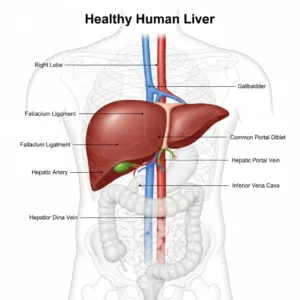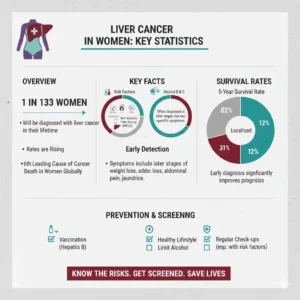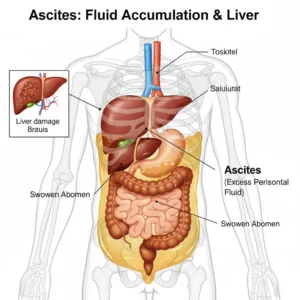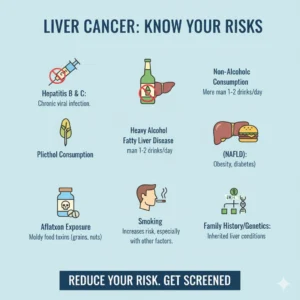Every year, thousands of women receive a liver cancer diagnosis that could have been caught earlier. The liver, one of your body’s most vital organs, often suffers in silence—showing no obvious symptoms until the disease has progressed significantly. This is why understanding the signs of liver cancer in women is not just important; it could be life-saving. While liver cancer affects both men and women, certain risk factors and symptoms manifest differently in women due to hormonal influences, lifestyle patterns, and genetic predispositions. This comprehensive guide will help you recognize the early warning signs, understand your risk factors, and take proactive steps to protect your liver health.

What Is Liver Cancer?
Your liver is a powerhouse organ located in the upper right side of your abdomen, performing over 500 vital functions. It filters toxins from your blood, produces bile for digestion, stores energy, and regulates blood sugar levels. When cancer develops in the liver, it disrupts these essential processes.
Liver cancer occurs when cells in the liver begin to grow abnormally and uncontrollably. The most common type is hepatocellular carcinoma (HCC), which starts in the main liver cells called hepatocytes. Another type, intrahepatic cholangiocarcinoma, begins in the bile ducts within the liver.
How Liver Cancer Affects Women Differently
Women face unique considerations when it comes to liver disease symptoms and cancer risk. Hormonal fluctuations throughout life—during menstruation, pregnancy, and menopause—can influence liver function and disease progression. Additionally, autoimmune liver diseases are more common in women, and conditions like non-alcoholic fatty liver disease (NAFLD) are increasing among women due to metabolic syndrome and obesity.

Early Warning Signs of Liver Cancer in Women
Recognizing the early signs of liver cancer in women can make the difference between successful treatment and advanced disease. Here are the critical symptoms every woman should monitor:
1. Unexplained Fatigue and Weakness
Persistent exhaustion that doesn’t improve with rest is often one of the first indicators of liver problems. When your liver struggles to filter toxins and produce energy-storing glycogen, your entire body suffers. This isn’t ordinary tiredness from a busy day—it’s a deep, overwhelming fatigue that interferes with daily activities.
What to do: If you experience unexplained fatigue lasting more than two weeks, especially combined with other symptoms, schedule a consultation with your healthcare provider.
2. Unexplained Weight Loss
Losing weight without trying might seem like a welcome change, but it’s a red flag for liver health. Cancer cells consume significant energy, and a struggling liver affects your metabolism and appetite. Women who lose 10 pounds or more without dietary changes or increased exercise should take this seriously.
What to do: Track your weight regularly and report any sudden, unintentional weight loss to your doctor immediately.

3. Loss of Appetite and Feeling Full Quickly
When liver cancer develops, you may notice a decreased desire to eat or feel full after consuming only small amounts of food. This occurs because an enlarged liver or tumor can press against your stomach, creating a sensation of fullness. The liver’s reduced ability to process nutrients also affects hunger signals.
What to do: Pay attention to changes in your eating patterns and discuss persistent appetite loss with a medical professional.
4. Upper Abdominal Pain or Discomfort
Pain or discomfort in the upper right side of your abdomen, just below your ribs, is a significant warning sign. This pain may start as a dull ache and progress to sharp discomfort. Some women describe it as a feeling of fullness or pressure in that area.
What to do: Don’t dismiss persistent abdominal pain as indigestion. Any pain lasting more than a few days warrants medical evaluation.
5. Abdominal Swelling (Ascites)
Fluid accumulation in the abdomen, known as ascites, causes noticeable swelling and bloating. Your abdomen may appear distended, and your clothes might feel tighter around your waist. This occurs when liver disease disrupts the balance of proteins and fluids in your body.
What to do: If you notice unusual abdominal swelling accompanied by discomfort, seek medical attention promptly.

6. Jaundice (Yellowing of Skin and Eyes)
Jaundice is one of the most recognizable signs of liver cancer in women. When your liver cannot properly process bilirubin (a yellow pigment from broken-down red blood cells), it accumulates in your body, causing your skin and the whites of your eyes to turn yellow. Your urine may also appear dark, and stools may become pale.
What to do: Jaundice requires immediate medical evaluation, as it indicates significant liver dysfunction.
7. Nausea and Vomiting
Chronic nausea and frequent vomiting can signal liver problems. When your liver fails to effectively filter toxins, these substances build up in your bloodstream, triggering nausea. This symptom often worsens in the morning or after eating.
What to do: If nausea persists for more than a week or interferes with your ability to eat, consult your doctor.
8. Easy Bruising and Bleeding
Your liver produces proteins essential for blood clotting. When liver function declines, you may bruise easily from minor bumps or experience bleeding from your gums or nose. Some women notice that small cuts take longer to stop bleeding.
What to do: Track any changes in bruising patterns and report excessive bleeding to your healthcare provider.
9. Itchy Skin
Persistent itching without a rash, especially on your hands and feet, can indicate liver problems. When bile salts accumulate in your bloodstream due to liver dysfunction, they deposit in your skin, causing intense itching.
What to do: If you experience unexplained itching that doesn’t respond to moisturizers or antihistamines, have your liver function checked.
10. Enlarged Liver or Spleen
You may feel a hard lump or mass under your ribs on the right side (liver) or left side (spleen). An enlarged liver feels firm and may extend below your rib cage. Some women notice this during self-examination or bathing.
What to do: Any palpable mass or unusual firmness in your abdomen requires immediate medical evaluation.
11. Fever and Night Sweats
Unexplained fever and night sweats can occur with liver cancer. Your body may be responding to the cancer cells or to infections that develop when your immune system is compromised by liver disease.
What to do: Persistent fever without an obvious cause, especially with other liver-related symptoms, should be investigated.
12. Confusion or Cognitive Changes
When your liver cannot filter toxins like ammonia from your blood, these substances can affect brain function—a condition called hepatic encephalopathy. Women may experience confusion, difficulty concentrating, memory problems, or personality changes.
What to do: Cognitive changes alongside other symptoms warrant urgent medical attention.
Risk Factors and Causes of Liver Cancer in Women
Understanding your risk factors for liver disease symptoms is crucial for prevention and early detection:
Major Risk Factors
Chronic Hepatitis B or C Infection: These viral infections are the leading causes of liver cancer worldwide. Women with chronic hepatitis should receive regular monitoring.
Cirrhosis: Long-term liver damage and scarring significantly increase cancer risk. Causes include alcohol abuse, viral hepatitis, and fatty liver disease.
Non-Alcoholic Fatty Liver Disease (NAFLD): Increasingly common in women, especially those with obesity, diabetes, or metabolic syndrome.
Excessive Alcohol Consumption: Regular heavy drinking damages liver cells and increases cancer risk, even in moderate amounts for some women.
Type 2 Diabetes: Women with diabetes have a higher risk of developing liver cancer, particularly when combined with obesity.
Obesity: Excess weight contributes to fatty liver disease and inflammation, creating conditions favorable for cancer development.
Genetic Conditions: Hereditary hemochromatosis, Wilson’s disease, and alpha-1 antitrypsin deficiency increase risk.
Exposure to Aflatoxins: These toxins from molds on improperly stored grains and nuts can damage liver cells.

Prevention Strategies
Get vaccinated against hepatitis B
Limit alcohol consumption or abstain completely
Maintain a healthy weight through balanced nutrition and regular exercise
Manage chronic conditions like diabetes effectively
Avoid sharing needles or personal items that may carry blood
Get tested for hepatitis C if you were born between 1945 and 1965 or have other risk factors
Practice safe sex to prevent hepatitis transmission
How to Support Liver Health Naturally
Your lifestyle choices play a significant role in maintaining liver health and supporting early cancer detection:
Nutrition for a Healthy Liver
Eat plenty of vegetables and fruits: Leafy greens, cruciferous vegetables, berries, and citrus fruits support detoxification.
Choose healthy fats: Omega-3 fatty acids from fish, nuts, and seeds reduce inflammation.
Limit processed foods: Reduce sugar, refined carbohydrates, and trans fats that stress your liver.
Stay hydrated: Water helps your liver flush toxins efficiently. Aim for 8-10 glasses daily.
Include liver-supporting foods: Garlic, turmeric, green tea, beets, and walnuts promote liver function.
Lifestyle Practices
Exercise regularly: Aim for at least 150 minutes of moderate activity weekly to reduce fatty liver risk.
Maintain a healthy weight: Gradual, sustainable weight loss benefits liver health significantly.
Avoid toxins: Limit exposure to environmental toxins, and use medications only as directed.
Don’t smoke: Smoking increases liver cancer risk and worsens liver disease.
Get regular checkups: Annual physical exams including liver function tests help detect problems early.
Manage stress: Chronic stress affects liver function through hormonal pathways.
When to See a Doctor
Schedule an appointment if you experience:
Any combination of the symptoms listed above
Persistent symptoms lasting more than two weeks
Family history of liver cancer or liver disease
Known risk factors like hepatitis infection or cirrhosis
Sudden worsening of existing liver condition symptoms
Early detection dramatically improves treatment outcomes. Your doctor may recommend blood tests, imaging studies like ultrasound or CT scans, and possibly a liver biopsy to diagnose liver cancer accurately.
Conclusion
Recognizing the signs of liver cancer in women empowers you to take control of your health. While liver cancer often develops silently, your body sends signals—fatigue, weight loss, abdominal pain, jaundice, and other symptoms we’ve discussed. Don’t ignore these warning signs or dismiss them as normal aging or stress.
Women’s health deserves attention and advocacy. By staying informed about liver health, understanding your risk factors, and maintaining regular medical checkups, you’re taking proactive steps toward early cancer detection. Remember, your liver works tirelessly for you every day—protecting it protects your life.
Trust your instincts. If something feels wrong, seek medical advice. Early intervention can make all the difference in successfully treating liver cancer and preserving your quality of life. You are your best health advocate—stay aware, stay informed, and stay healthy.

Leave a Reply